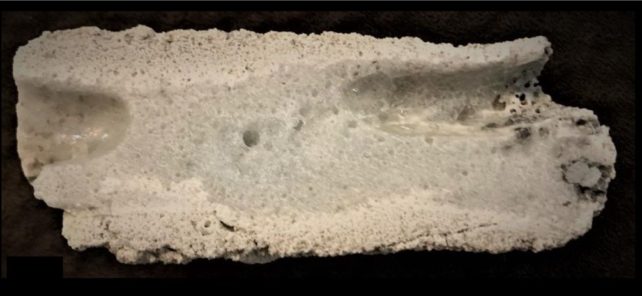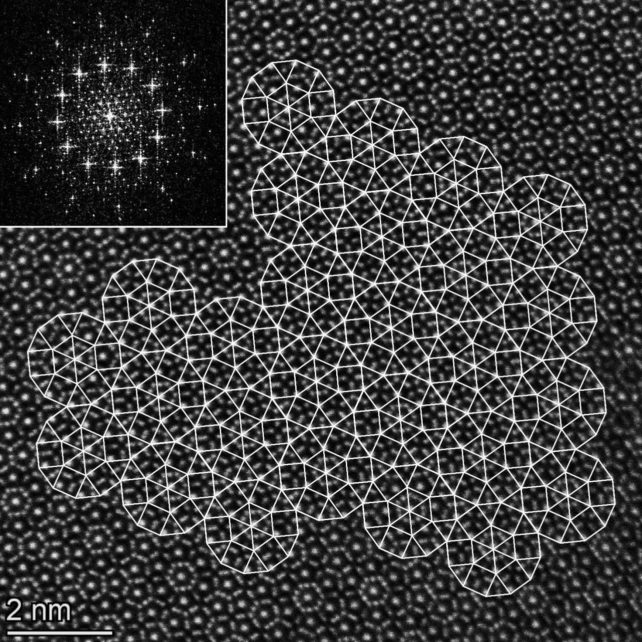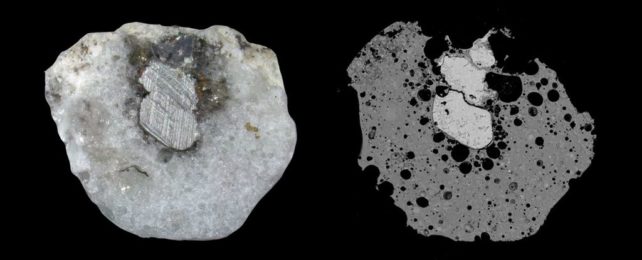The violent fingers of electricity that struck a sand dune in Nebraska have left behind a configuration of crystal rarely found in nature.
Inside a piece of fulgurite – or 'fossilized lightning' – created by a powerful bolt of electricity traveling into and fusing sand, scientists have found a quasicrystal, an arrangement of matter once thought to be impossible.
This discovery suggests there are previously unknown formation pathways for quasicrystals, opening up new avenues for their synthesis in the laboratory.
"The current investigation was designed to explore a different possible nature-inspired mechanism for generating quasicrystals: electrical discharge," write a team of researchers led by geologist Luca Bindi of the University of Florence in Italy in their paper.
"The discovery of a quasicrystal in a fulgurite with rarely observed 12-fold symmetry and a not been reported previously composition indicates that this approach may also be promising in the laboratory."

Most crystalline solids in nature, from the humble table salt to the toughest diamonds, follow the same pattern: their atoms are arranged in a lattice structure that repeats in three-dimensional space.
Solids that don't have these repeating atomic structures – amorphous solids like glass – are generally an atomic mess, a jumble of atoms mooshed in together with no rhyme or reason.
Quasicrystals break the rule – their atoms are arranged in a pattern, but that pattern does not repeat.
When the idea of quasicrystals first emerged in the 1980s, the concept was thought impossible. Solids could be either crystalline or amorphous, not this weird in-between. But then scientists actually found them, in both the laboratory setting and in nature, deep inside meteorites.
Since then, scientists have determined that quasicrystals in nature can only form under extreme conditions, with incredibly high shock, temperature, and pressure.
Hypervelocity meteorite impacts is one such setting; in fact, for a long time, it was the only setting in which they had been found in nature, and was thus thought to be possibly the only place they could occur.
Then Bindi and his colleague, physicist Paul Steinhardt of Princeton University, along with their team, found a quasicrystal forged during a nuclear bomb test in 1945. Although not exactly 'natural' conditions, the discovery suggested that there might be other settings in which quasicrystals could form.
Lightning is one of the most powerful forces in nature, striking with extreme speed, and can heat the air it passes through to 5 times the temperature of the surface of the Sun.
And, when it hits the ground in the right place with enough power, it can melt sand, leaving behind a fulgurite – a 'fossil' of the path it traveled through the ground.
All the ingredients are there: shock, temperature, and pressure. So Bindi, Steinhardt, and their colleagues set about investigating fulgurites for quasicrystals.
They obtained a fulgurite sample from the Sandhills region of Nebraska, retrieved from a site close to a fallen power line, and subjected it to scanning electron microscopy and transmission electron microscopy, to determine its chemical composition and crystalline structure.

The sample consisted of fused sand, and traces of melted conductor metal from the power line. Within it, the researchers found a dodecahedral (twelve-sided) quasicrystal with the previously unreported composition Mn72.3Si15.6Cr9.7Al1.8Ni0.6.
The atoms in this quasicrystal formed a pattern with a 12-fold symmetry, arranged in a quasicrystalline order impossible in normal crystals.
It's unclear whether lightning or the power line were responsible for the electricity that created the fulgurite; however, based on their analysis, the team determined that the sand had to have been heated to at least 1,710 degrees Celsius (3,110 degrees Fahrenheit) to create the fulgurite.
This, the researchers say, gives clues about how scientists could create quasicrystals in the lab. Quasicrystals found in a meteorite suggested that shock synthesis could be one way; lightning offers new possibilities.
"The discovery of a dodecagonal quasicrystal formed by a lightning strike or downed power line suggests that electric discharge experiments may be another approach to be added to our arsenal of synthesis methods," they write in their paper.
And the discovery points to what could be previously overlooked quasicrystal formation pathways – both on Earth, and beyond.
"The results presented here, together with the trace element abundances measured in natural quasicrystals, open the possibility that electric discharge in the early solar nebula may have played a key role that not only accounts for the requisite reducing conditions but also promotes quasicrystal formation."
The research has been published in PNAS.
